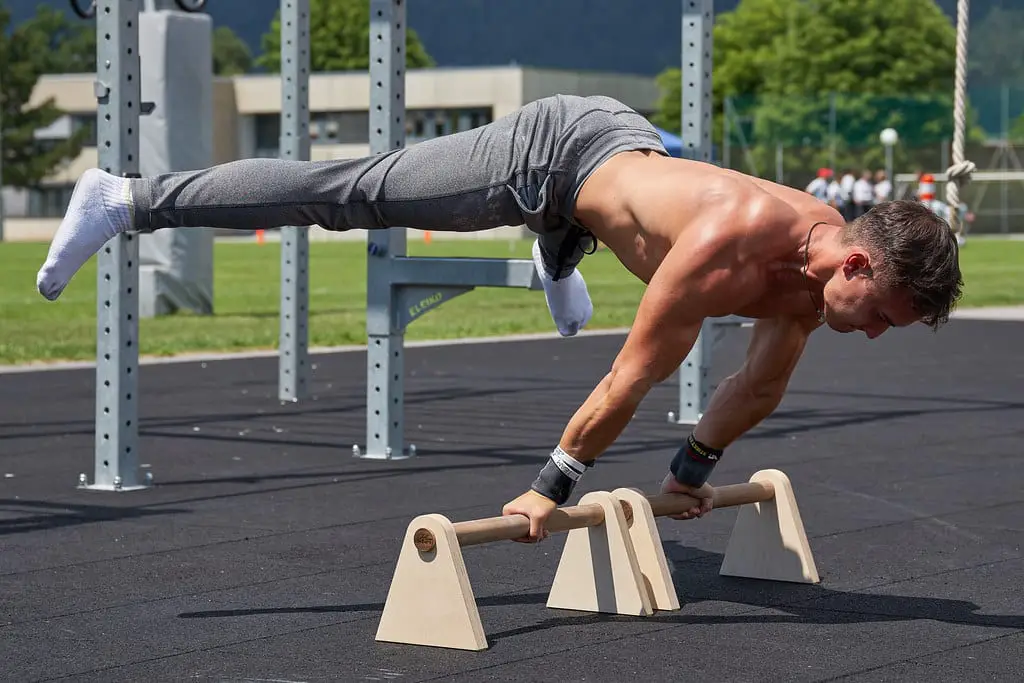Introduction
Is Calisthenics Better Than Weights: The debate between calisthenics and weight training has long been a topic of discussion among fitness enthusiasts and experts alike. Both forms of exercise offer unique benefits and cater to different fitness goals. Calisthenics, which involves using your body weight for resistance in exercises like push-ups, pull-ups, and squats, has gained popularity for its simplicity and accessibility. On the other hand, weight training, which utilizes external weights such as dumbbells and barbells, is a staple in gym workouts for building muscle and strength.
The advantages and disadvantages of both calisthenics and weight training. We will delve into the specific goals each method can help you achieve, the physiological differences between the two, and how individual preferences and circumstances can influence the choice between these two approaches to fitness. By understanding the nuances of both calisthenics and weight training, you can make an informed decision about which is better suited to your personal fitness objectives.
The choice between calisthenics and weight training is not a one-size-fits-all decision; it depends on your fitness goals, preferences, and circumstances. Calisthenics offers several benefits, including the ability to perform these exercises virtually anywhere, as they rely on your body weight as resistance. Calisthenics can improve overall strength, endurance, flexibility, and functional fitness. They are also beginner-friendly, requiring minimal equipment. Weight training, on the other hand, is known for its capacity to build muscle and increase strength efficiently. It allows for more precise resistance adjustments, making it easier to progressively overload muscles, a key principle in muscle growth. Weight training is particularly effective for bodybuilders, powerlifters, and those focused on hypertrophy.

Are calisthenics better than weightlifting?
Calisthenics workout involves compound exercises, as it uses multiple muscle groups at once. Hence, it is better for burning calories, whereas weight training contains isolated movements that do not require a lot of energy.
Safety and Joint Health: Calisthenics, which rely on bodyweight resistance, are generally considered safer for beginners and those concerned about joint health. There’s less risk of using improper form or lifting excessive weights that could lead to injuries. Calisthenics can also strengthen joints and improve mobility.
Strength and Muscle Building: Weightlifting is highly effective for building muscle and increasing strength. It allows for precise control over resistance, making it easier to progressively overload muscles, a key factor in muscle growth. If your primary goal is to gain significant muscle mass or compete in strength sports, weightlifting might be a better choice.
Convenience and Accessibility: Calisthenics can be performed anywhere without the need for specialized equipment, making them highly accessible. Weightlifting, on the other hand, often requires access to a gym with weights and equipment.
Variety: Both calisthenics and weightlifting offer a wide range of exercises, and variety can be essential for maintaining interest and challenging different muscle groups. You can incorporate elements of both into your fitness routine to keep things fresh.
Injury Risk: While calisthenics are generally considered safer, it doesn’t mean weightlifting is inherently dangerous. With proper form and technique, the risk of injury in weightlifting can be minimized. Safety precautions, such as using spotters and appropriate warm-ups, are crucial.
Do calisthenics build muscle faster than weights?
Bodyweight exercises and lifting weights help build strength, but they do so in different ways. For example, weightlifting is better for building ABSOLUTE strength, while calisthenics is better for developing RELATIVE strength.
Calisthenics for Lean Muscle: Calisthenics can help you build lean muscle and improve overall strength and endurance. These exercises use your body weight as resistance and are excellent for functional fitness. Calisthenics may not lead to rapid muscle bulking like heavy weightlifting, but they can create a lean and well-defined physique, especially when combined with progressive overload techniques.
Weightlifting for Muscle Growth: Weightlifting, especially when focused on compound movements like squats, deadlifts, and bench presses, is highly effective for muscle growth (hypertrophy). With the right training program and nutrition, weightlifting can help you bulk up and add substantial muscle mass. It allows for precise control of resistance, which is essential for muscle hypertrophy.
Combining Both: Many individuals find success by incorporating elements of both calisthenics and weightlifting into their routines. This approach provides a balanced workout, combining the benefits of bodyweight exercises for functional strength and weightlifting for muscle growth.
Diet and Nutrition: Regardless of the exercise method you choose, diet and nutrition play a crucial role in muscle growth. To build muscle effectively, you need to consume enough protein and maintain a caloric surplus (more calories in than you burn).
Can you build muscle with only calisthenics?
Calisthenics is amazing for building functional, full-body muscle but there is a limit to the amount of sheer mass you can gain with calisthenics. Calisthenics will build as much muscle as free weights to a point, but if you want to push past that point then you’ll need to train (and eat) like a bodybuilder.
Functional Muscle: Calisthenics promotes functional muscle development, which means you’ll build strength and muscle that is useful for various activities and movements in your daily life. It emphasizes bodyweight exercises like push-ups, pull-ups, dips, and bodyweight squats, which engage multiple muscle groups simultaneously.
Limitations for Mass: While calisthenics can help you gain significant muscle mass, there is a limit to how much mass you can build compared to traditional weightlifting. Weightlifting allows for more precise control over resistance and can lead to faster muscle hypertrophy (growth) due to the ability to progressively overload muscles with heavier weights.
Progressive Overload: To continue building muscle with calisthenics, you’ll need to incorporate progressive overload techniques. This involves increasing the difficulty of exercises by adjusting angles, adding resistance bands, or performing advanced variations of bodyweight exercises.
Nutrition Matters: Just like with any muscle-building program, proper nutrition is crucial. You’ll need to ensure you’re consuming enough calories, especially protein, to support muscle growth.
Hybrid Approaches: Many individuals combine calisthenics with weight lifting or resistance training to maximize muscle growth. This hybrid approach can offer the best of both worlds by emphasizing functional strength from calisthenics while also allowing for more targeted muscle-building with weights.
Is calisthenics harder than weight lifting?
Here are some reasons why some people might find calisthenics harder than lifting: Bodyweight Resistance: Calisthenics primarily use your body weight as resistance, whereas lifting typically involves lifting external weights.
Bodyweight Resistance: Calisthenics primarily use your body weight as resistance, which can be challenging for some individuals, especially when performing advanced exercises like one-arm push-ups, handstand push-ups, or muscle-ups. This makes calisthenics exercises require significant relative strength.
Skill and Balance: Many calisthenics movements require a high level of skill and balance, such as handstands, planches, and levers. Developing these skills can be demanding and take time.
Progressive Overload: Achieving progressive overload (making exercises more challenging over time) in calisthenics can be trickier than with weightlifting, as you need to adjust body positioning, leverage, or incorporate additional resistance (e.g., weighted vests or resistance bands).
Weightlifting Challenges:
Lifting Heavy Weights: Weightlifting involves lifting external weights, which can be exceptionally heavy. It requires not only strength but also proper form and technique to prevent injury.
Muscle Isolation: Weightlifting often focuses on specific muscle groups, requiring the isolation of those muscles during exercises. This precision can be challenging to achieve.
Complex Movements: Certain weightlifting exercises, such as Olympic lifts (e.g., snatch and clean and jerk), require mastering complex movements, which can be technically challenging.
Who is a more powerful bodybuilder or calisthenics?
Calisthenics Vs Bodybuilding Strength
In terms of raw power and the ability to lift heavy weights, bodybuilding often comes out on top. However, when it comes to functional strength, relative strength (strength in relation to body size), and body control, calisthenics practitioners typically excel.
Bodybuilding: Bodybuilders are known for their impressive muscle mass, sculpted physiques, and the ability to lift heavy weights. They focus on hypertrophy (muscle growth) and often prioritize lifting progressively heavier loads during their workouts. This emphasis on sheer muscle size and strength makes bodybuilders formidable in terms of raw power and lifting capacity.
Calisthenics: Calisthenics enthusiasts, on the other hand, prioritize functional strength, relative strength (strength in relation to body size), and body control. Calisthenics routines typically involve bodyweight exercises like push-ups, pull-ups, dips, and gymnastic movements. This training style emphasizes mastering one’s body weight, achieving advanced skills like planches, handstands, and levers, and developing exceptional relative strength.
Who is stronger calisthenics or gym?
There are many reasons why calisthenics is more beneficial than machines or weights. First, calisthenics work your entire body – not just isolated muscle groups as machines or weights can. This means that you’ll get more overall fitness benefits from calisthenics than from weightlifting or using machines at the gym.
The comparison between calisthenics and gym-based workouts often centers around the concept of strength.
Full-Body vs. Isolation: Calisthenics primarily involve compound movements that engage multiple muscle groups simultaneously. This functional approach can lead to improved overall strength and athleticism. Weightlifting in the gym often focuses on isolated muscle groups, which can lead to strength gains in specific areas.
Body Weight vs. External Resistance: Calisthenics rely on your body weight as resistance, making it a bodyweight-centric form of strength training. Gym workouts often incorporate external weights, allowing for precise resistance adjustments and potential for heavier loads. This can be advantageous for developing maximal strength.
Functional Strength: Calisthenics place a strong emphasis on functional strength, which is the ability to apply strength to real-world movements and activities. This is particularly valuable for everyday activities and sports. Weightlifting, while building muscle and strength, may not always translate directly to functional strength.
Progressive Overload: Both calisthenics and gym workouts can incorporate progressive overload, the gradual increase in resistance or intensity to stimulate muscle growth and strength gains. However, gym workouts have more straightforward options for increasing resistance through weights.
Variety and Adaptation: Calisthenics often involve a wide variety of movements and exercises, contributing to overall fitness and adaptability. Gym workouts can be tailored to specific goals, allowing for focused muscle development.
Can calisthenics replace weightlifting?
If your end goal is to build strength, coordination, mobility, flexibility, and overall body control, then calisthenics are for you. There are even more advanced calisthenic techniques that you can learn along the way to help with this. For better muscle growth and mass, weights could be the answer for you.
Strength and Muscle Building: Calisthenics can help you build functional strength and muscle, especially if you incorporate advanced bodyweight exercises and progressive overload techniques. However, traditional weightlifting, which allows for precise control over resistance, can be more effective for maximal muscle hypertrophy (growth) in specific muscle groups.
Variety: Calisthenics offers a wide range of bodyweight exercises that can target various muscle groups and improve overall fitness. Weightlifting, while effective, may not provide the same diversity of movements and exercises.
Functional Strength: Calisthenics excels in promoting functional strength, which is the ability to apply strength to real-world movements and activities. This makes it valuable for everyday activities and sports.
Access and Convenience: Calisthenics can be performed virtually anywhere, making it a convenient option, especially when you don’t have access to gym equipment. This flexibility can be advantageous for consistent training.
Individual Goals: The choice between calisthenics and weightlifting should align with your fitness goals. If you prioritize functional strength, full-body fitness, and bodyweight mastery, calisthenics may be sufficient. However, if you have specific goals related to maximal muscle growth or powerlifting, weightlifting may be necessary.
Are calisthenics stronger than powerlifters?
Another thing worth mentioning is calisthenics athletes are freakishly strong, even though they train far differently than the typical bodybuilders or powerlifters. Calisthenics athletes may still be able to hit those heavy compound movements, or do a lot on the lat pulldown, and we are going to discuss why.
Calisthenics Athletes:
- Excel in relative strength (strength in relation to body weight).
- Perform advanced bodyweight exercises like planches, handstand push-ups, and one-arm pull-ups.
- Demonstrate exceptional body control, balance, and mastery of bodyweight movements.
- Prioritize functional strength and often excel in movements related to body control and agility.
Powerlifters:
- Focus on absolute strength (the maximum weight lifted).
- Compete in the “big three” powerlifting movements: squat, bench press, and deadlift.
- Lift heavy external weights, often exceeding double their body weight in these movements.
- Emphasize maximal strength in specific muscle groups for competition.
- Both calisthenics athletes and powerlifters are strong, but their strengths lie in different aspects of strength. Calisthenics athletes prioritize relative strength, body control, and functional movements, while powerlifters focus on lifting heavy external weights in specific powerlifting movements.

Conclusion
The debate between calisthenics and weightlifting ultimately comes down to individual goals, preferences, and priorities in fitness. Both forms of exercise offer a plethora of benefits and have their unique strengths. Calisthenics excels in promoting functional strength, bodyweight mastery, and relative strength. It is highly accessible, requiring minimal equipment and offering versatility for workouts anywhere.
Weightlifting, on the other hand, is a powerhouse for building maximal strength and muscle mass. It allows for precise control over resistance and is ideal for those with specific goals in powerlifting or bodybuilding. Weightlifting can lead to impressive gains in absolute strength. Calisthenics also emphasizes full-body engagement and can lead to improved body control and agility.
The best approach often involves incorporating elements of both calisthenics and weightlifting to create a well-rounded fitness routine. This balanced approach can provide functional strength, muscle growth, and overall fitness. Ultimately, the choice should align with one’s fitness objectives and what they find enjoyable and sustainable, as both calisthenics and weightlifting have their place in the world of fitness.

